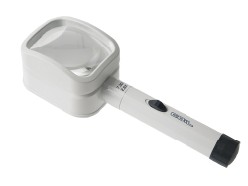Low Vision Aids
Low Vision Aids Prescription in Delhi
Patients with low vision can find it hard to perform all activities like driving, reading, or having blurry faces Sorely, number suffers are told that there's nothing to be doresultingsult in a loss of desire in addition to their loss of independence.
Low vision aids assist you in visualizing the regular challenges posed by eye conditions like macular degeneration, diabetic retinopathy, glaucoma, and retinitis pigmentosa. The success of this appliance is well-proven.
With the help of these innovative vision aids, magnifiers, spectacles, appliances, and other technologies eye consultants can sufferers of all ages overcome the limitations of low vision.
Types of Low vision
• Loss of central vision: There's an eyeless spot in the center of one's vision.
• Loss of side vision: The incapability to see anything to either side, over, or below eye position. Central vision, still, remains perfect.
• Night blindness: The incapability to see in inadequately lit areas like theaters, as well as outdoors at night.
• Blurry vision: Objects both near and far off appear out of focus.
• Hazy vision: The entire field of vision appears to be covered with a film or glower.
Optometrist Prescribe Low Vision Aids
Magnifying Specs

Magnifying Specs are worn like eyeglasses, and help you see better for tasks like reading, threading needle stitching, ich, etc. Hand-free magnifier allowing you to work with your hands
Stand Magnifiers

These magnifiers are placed down from your eye, on the object you're trying to read. The handheld types are also available for reading, and these generally have erected-in lights. In case you have arthritis, stand magnifiers are best suited for you.
Tele Microscope

Telescope spectacles enable one or more ore to see distant objects, such as a road sign while driving, and microscope spectacles provide a better up-close vision for tasks like reading the newspaper or a phone screen.
Video Magnifiers
These electronic tools make printed text or images and look text images bigger. The cheapest available “ video magnifiers ” are in smartphones and tablets that allow you to increase the discrepancy and font size of text.
OrCam Read

OrCam Read is a handheld reading device for people with mild low vision, reading fatigue, and reading issues, including dyslexia. It has a smart camera that reads text audibly from any print text or digital screen. OrCam Read enables one to read a book, a bill, or the print edition of the morning news, and can also read on a digital display.
Feel free to Contact us at +91-8130780790 for your Child Eye Problems and Eye Surgery.
Frequently asked question
To manage low vision aid, individuals can utilize various technologies, apps, and devices designed to assist people with vision impairments in their daily activities. These tools aim to make tasks easier and enhance independence for those with low vision. Some strategies to manage low vision aid include: Utilizing Technology: From artificial intelligence to voice control, some apps and devices can assist individuals with low vision in navigating, reading, and engaging in various activities. These technologies can be used on smartphones or tablets, offering features like large fonts, high contrast, voice commands, and more. Consulting with a Low-Vision Specialist: Seeking help from a low-vision specialist or an optometrist can provide personalized recommendations on the best aids and devices to address specific visual needs. These specialists can customize digital devices and apps, offer training on how to use assistive tools effectively, and tailor solutions to individual visual challenges. Engaging in Vision Therapy: Vision therapy, which includes eye exercises, testing, occlusion, and using lenses and prisms, can help improve visual abilities for individuals with certain visual conditions like amblyopia and eye alignment problems. Vision therapy programs are designed to suit the specific needs of each individual and can enhance eye coordination and focusing abilities. Exploring Vision Therapy for Dyslexia and Learning Disabilities: Vision therapy can also benefit individuals with dyslexia, ADD/ADHD, and learning disabilities by improving and strengthening visual functions, retraining the brain to interpret visual information, and addressing underlying vision problems that may contribute to reading difficulties and attention issues. By combining technology tools, consulting with specialists, engaging in vision therapy, and exploring tailored solutions for specific visual challenges, individuals with low vision can effectively manage their condition and improve their quality of life.
Low vision refers to moderate to severe visual impairment that cannot be corrected with prescription lenses or surgery. It means having trouble seeing clearly, like having spots where you can't see, finding it hard to see at night, or having blurry vision. But it doesn't mean being completely blind because you can still see a little bit. Common causes of low vision include age-related macular degeneration, glaucoma, and diabetes. Visual aids can assist individuals with low vision in managing their condition and improving their quality of life



